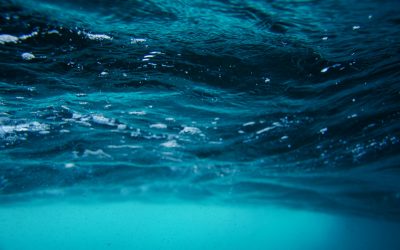From Caves to Cosmos: Diamagnetism in Space
This topic starts all the way back in 1972 with A.G.O.’s founder, Jim Harrington. While propecting for gold in Deloro, Ontario, he discovered not only evidence of gold ore, but also fluorite crystals.
A geophysicist by trade, he was familiar with many properties of rocks and ores, except one: Diamagnetism. On a trip to the Royal Ontario Museum with his son, an exhibit on magnetism introduced him to the term and taught that fluorite and arsenopyrite – both present at his prospecting property – are diamagnetic materials. Jim was hooked.
So began a lifelong fascination. Although not a heavily researched field, new discoveries in the field of diamagnetism and diamagnetic materials over the decades only added to Jim’s curiosity, eventually inspiring the question of whether they could be applied to satellite control and propulsion systems.
From 2012 to 2015, Jim and A.G.O. Environmental partnered with the University of Victoria’s ECOSat satellite design club to take this hypothesis to the cosmos from its origins in the caves in Jim’s prospecting property.
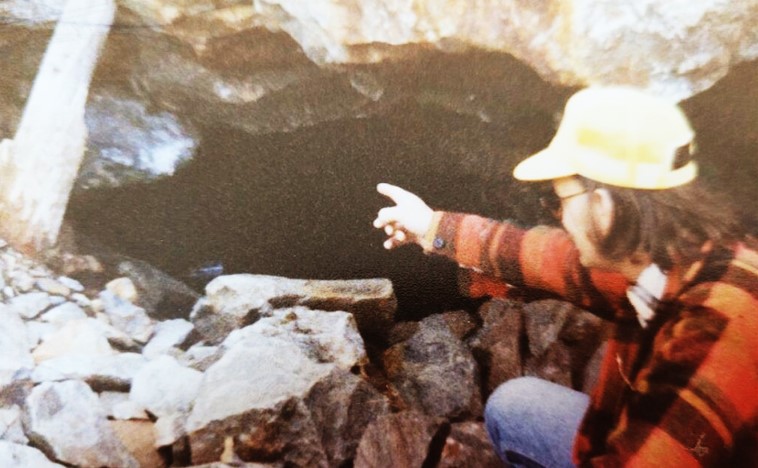
Jim Harrington at his prospecting property in Deloro, Ontario in the 1970’s. He is pointing out a large chunk of arsenopyrite, an ore deposit indicative of gold.
What is Diamagnetism?

Diamagnetism is the property that causes some materials to be (weakly) repelled by an external magnetic field [1].
It can be observed with a simple, high precision scientific weigh scale set up where magnets are placed on the weigh scale, and a diamagnetic material is lowered over the magnets. Although the material never touches the magnets, the weak repulsion between the diamagnetic material and the magnets’ field effectively pushes the magnets down on the weight scale, increasing their apparent weight [2].
The video shown here from Dr. Charles Clark at the University of Maryland Joint Quantum Institute demonstrates TeachSpin’s weigh scale built specifically for this experiment [3]. (Learn more here: https://www.teachspin.com/fms)
The Curious Diamagnetic Properties of Pyrolytic Graphite
In the majority of diamagnetic materials, diamagnetism is observed to be temperature independent, with materials exhibiting a constant diamagnetic strength regardless of how hot or cold they become [1]. Pyrolytic graphite, however, is shown to exhibit a weaker diamagnetic response when its temperature increases. Pyrolytic graphite is the only known material to demonstrate temperature-dependendant diamagnetism.
This phenomenon can be observed by heating a sample of pyrolytic graphite with an ultraviolet laser. Pyrolytic graphite is strongly diamagnetic at room temperture, such that a small sample can levitate above a bed of magnets. When heated eccentrically by an ultraviolet laser, the material’s diamagnetic repulsion force can be reduced on one side or another of the sample, inducing a force differential that causes the sample to “scoot” towards the laser, propelled by the relatively higher forces on its unheated edge.
Japanese researchers Masayuki Kobayashi and Jiro Abe published these findings in 2012 [4]. Jim’s reproduction of their results is shown in the video here. He also found that an infrared laser was similarly capable of heating the sample and producing the same movement effects.
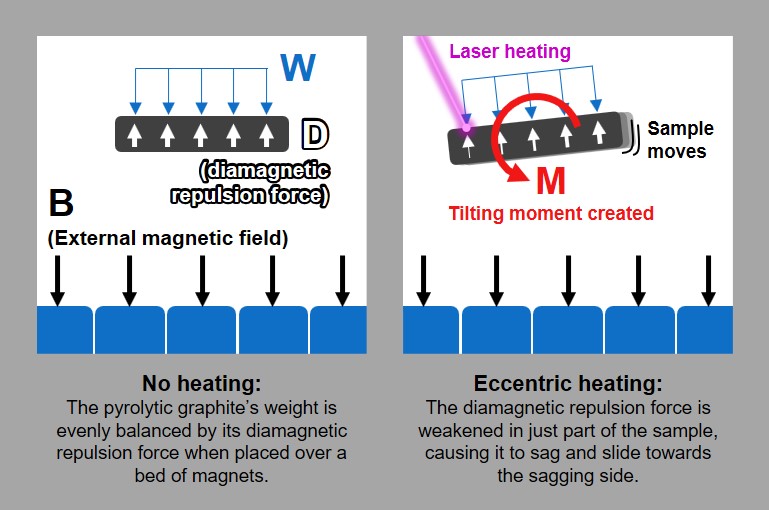
UVic's ECOSat2: Diamagnetism Applications in Space
Although pyrolytic graphite exhibits the strongest diamagnetic response of all diamagnetic materials, its reaction is still too weak to be made useful on Earth. Inspired by his time building satellites at the Herzberg Astronomy and Astrophysics Research Center in Ottawa, Ontario in the 80’s, Jim hypothesized that its temperature-dependent diamagnetic reaction effects could instead be applied to implement a light-based propulsion and/or attitude control system for satellites. Jim and A.G.O. partnered with the University of Victoria’s ECOSat team to design cubesat experiments to study this hypothesis.
UVic’s satellite design team designed a cube satellite with several experiments on board designed to study how diamagnetic pyrolytic graphite interacts with the Earth’s magnetic field in a micro-gravity environment, with the goal of inspiring more research to be done on potential applications of diamagnetism in space [5, 6]. Pyrolytic graphite’s properties have high potential for being harnessed as a low-energy method to accelerate or reposition a satellite [7].
The ECOSat2 satellite used solar-powered lasers to heat pyrolytic graphite samples attached within the satellite. In theory, the satellite’s positioning relative to the Earth’s magnetic field could be manipulated simply by activating heating lasers directed at different parts of the graphite sample and creating a similar force gradient within the Earth’s magnetic field as observed by Kobayashi and Abe.
The ECOSat2 cubesat won the Canadian Satellite Design Challenge in 2014 and secured an opportunity to launch [8, 9]! Unfortunately the launch was scrubbed due to weather, and the ECOSat2 experiments were ultimately never tested in space.
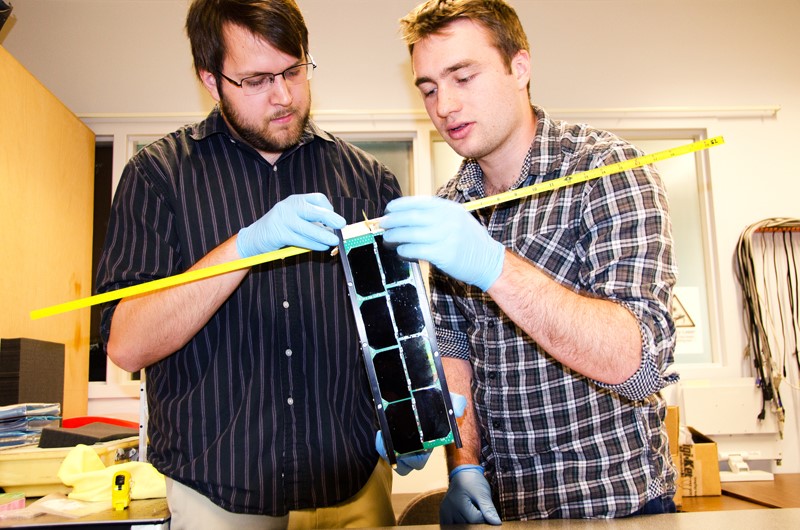
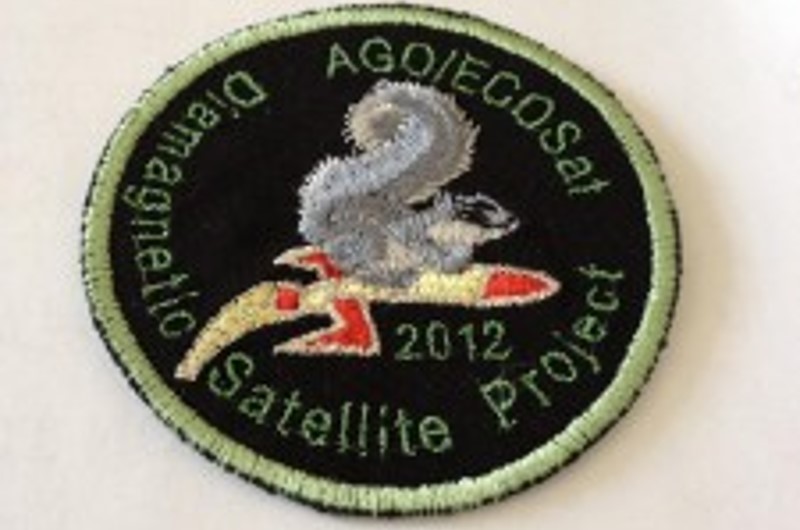
Next Steps
Unfortunately, with the scrubbing of the ECOSat2’s launch opportunity, it is unlikely that these experiments will be tested in space until another dedicated company or research group is willing to invest in developing a similar satellite and ensuring it gets launched.
Jim intends to continue investigating other means of influencing and strengthening diamagnetic properties, e.g. potentially through photoelectric excitation of certain materials, investigation of new materials, material “doping”, etc. Ultimately, Jim hopes that his curiosity and fascinating empirical observations may inspire other researchers to conduct more formal investigations and publish results that can be applied towards new discoveries in areas like space propulsion.
References
[1] R. Boča, “Types of Magnetic Materials,” in Current Methods in Inorganic Chemistry. Lausanne, (Switzerland): Elsevier Science S.A., 1999, ch.7, pp. 345-370. Accessed: 4 June 2025. [Online]. Available: https://doi.org/10.1016/S1873-0418(99)80008-6
[2] TeachSpin, Inc., “Foundational Magnetic Susceptibility,” teachspin.com. https://www.teachspin.com/fms (accessed 4 June 2025).
[3] Charles Clark. Experimental demonstration of diamagnetism. (9 March 2015). Accessed: 4 June 2025. [Online video]. Available: https://www.youtube.com/watch?v=1-qiPFpQPfs&t=11s
[4] M. Kobayashi and J. Abe, “Optical motion control of Maglev graphite,” Journal of the American Chemical Society, vol. 134, no. 51, pp. 20593-20596, 12 December 2012. Accessed: 4 June 2025. [Online]. Available: https://doi.org/10.1021/ja310365k\
[5] UVic ECOsat, https://www.ece.uvic.ca/~elec399/projects_052012/csdc.uvic.ca/home.php (accessed 4 June 2025).
[6] J. Curran and C. Hussman, “Pioneering the application of diamagnetic materials for spacecraft attitude control,” IEEE, vol. 53, no. 5, pp. 200-201, 14 May 2015. Accessed: 4 June 2025. [Online]. Available: https://doi.org/10.1109/MCOM.2015.7105662
[7] G. Horta dos Reis, “Thermal influence on the diamagnetic properties of
pyrolytic graphite: Applications in space and high speed transportation,” M.S. thesis, Aerospace Eng., Instituto Superior Técnico, Lisbon, Portugal, 2015. [Online]. Available: https://fenix.tecnico.ulisboa.pt/downloadFile/281870113702878/Thermal%20Influence%20on%20the%20Diamagnetic%20Properties%20of%20Pyrolytic%20Graphite%20%20Applications%20in%20Space%20and%20High%20Speed%20Transportation.pdf
[8] K. Derosa, “University of Victoria students’ tiny satellite aims for the stars,” timescolonist.com. https://www.timescolonist.com/local-news/university-of-victoria-students-tiny-satellite-aims-for-the-stars-4610718 (accessed 4 June 2025).
[9] M. McLeod, “UVic engineering team wins satellite design challenge,” design-engineering.com. https://www.design-engineering.com/uvic-engineering-team-wins-satellite-design-challenge-131765/ (accessed 4 June 2025).
More R&D at A.G.O.
Are deep sea water samples pressurized?
Water is considered to be functionally incompressible, unless under extreme pressures such as those at the bottom of the ocean. This brings up an interesting question: If you bring a sample of high-pressure deep sea water back to the surface enclosed in a container, what happens to the container?

